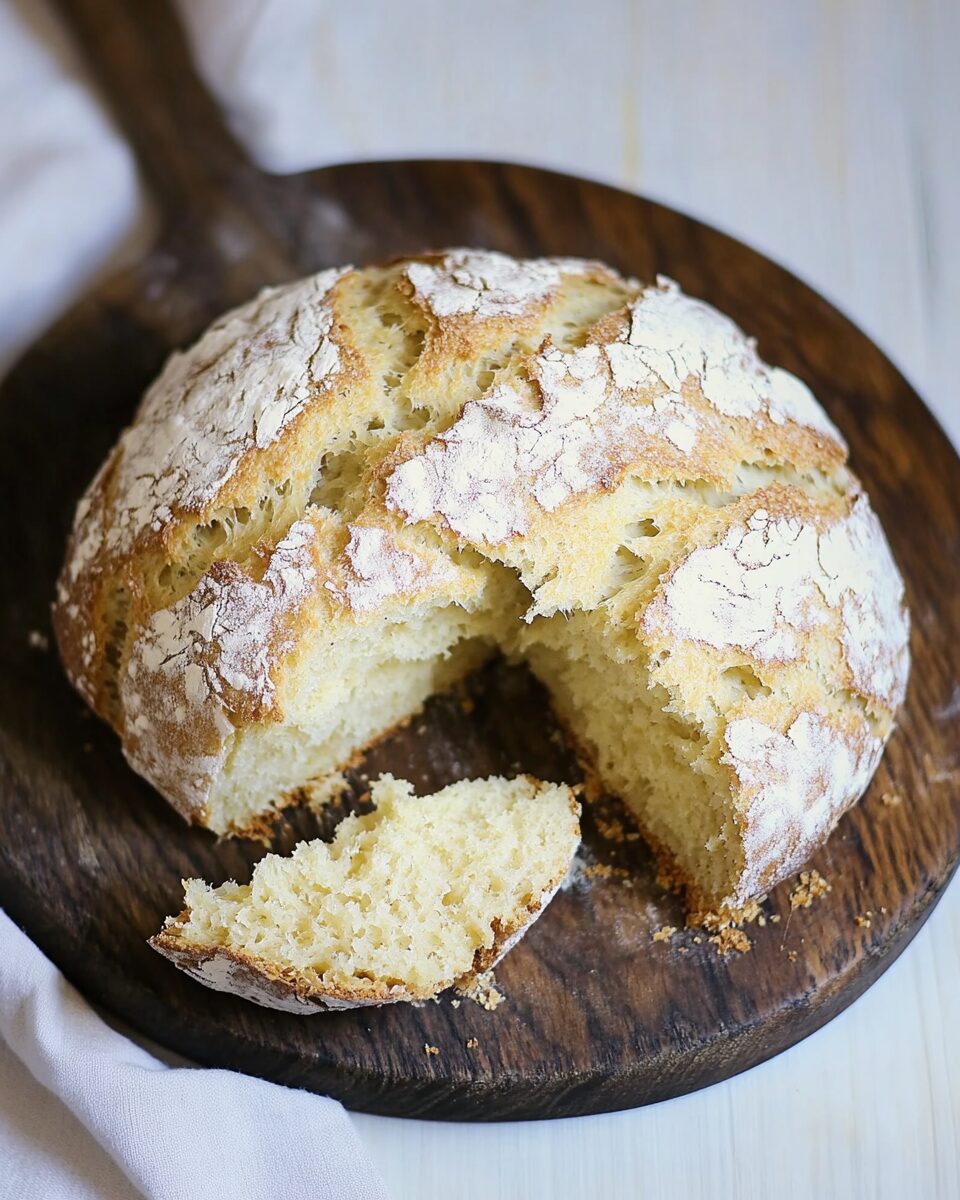Irish Soda Bread is a true staple of Irish cuisine, cherished for its simplicity and rich history. Made with only four essential ingredients—flour, baking soda, salt, and buttermilk—this quick bread was a lifesaver for families during tough times in Ireland. Its signature crusty exterior and soft, dense interior make it perfect for pairing with soups, stews, or just a generous slather of salted butter.
What makes this bread so special is its no-fuss preparation. No yeast means no waiting—just mix, shape, and bake! The deep cross cut on top isn’t just for tradition; it ensures even baking and a perfect texture. Whether you’re celebrating St. Patrick’s Day or just looking for a comforting homemade bread, this traditional recipe is an absolute must-try.
Full Recipe:
- 4 cups all-purpose flour (or 3 cups all-purpose + 1 cup whole wheat)
- 1 ¾ cups buttermilk (or milk soured with 2 Tbsp lemon juice or vinegar)
- 1 ½ teaspoons baking soda
- 1 ½ teaspoons salt
Directions:
- Preheat the oven to 400°F (200°C). If using a baking stone, place it in the oven to heat.
- Prepare buttermilk substitute if necessary by adding lemon juice or vinegar to milk and letting it sit for 5 minutes.
- Mix dry ingredients in a large bowl: whisk together flour, baking soda, and salt.
- Form the dough by creating a well in the center of the flour and pouring in buttermilk. Stir with a fork until a sticky dough forms.
- Knead lightly on a floured surface just three or four times, then shape into a round loaf. Do not over-knead.
- Score the bread with a deep ‘X’ across the top using a sharp knife. This allows even baking.
- Bake on a lined baking sheet or cast-iron skillet for about 45 minutes (for a large loaf) or 35 minutes (for two smaller loaves).
- Check doneness by tapping the bottom of the loaf—if it sounds hollow, it’s ready.
- Cool the bread on a rack for at least 10 minutes before slicing and serving with salted butter.
Prep Time: 10 minutes | Cooking Time: 45 minutes | Total Time: 55 minutes
Kcal: 272 kcal | Servings: 8
The History and Tradition Behind Irish Soda Bread
Irish Soda Bread is one of the most iconic and beloved breads in Irish cuisine. With a rich history dating back to the 19th century, this simple yet hearty bread became a staple in Irish households due to its affordability and ease of preparation. Unlike yeast breads, which require proofing and rising time, soda bread relies on a chemical reaction between baking soda and buttermilk to create its airy texture.
The traditional recipe calls for only four essential ingredients: flour, baking soda, salt, and buttermilk. This simplicity is what makes it so special. While many modern variations exist, adding sugar, raisins, or even eggs, purists believe that these additions turn it into a “tea cake” rather than a true soda bread. The Society for the Preservation of Irish Soda Bread upholds that the most authentic version sticks to the original four ingredients, keeping it as close to its historic roots as possible.
Why Did Soda Bread Become Popular in Ireland?
The rise of Irish Soda Bread can be traced back to the mid-1800s, during a time when Ireland was facing economic hardships. Wheat that grew in Ireland was of the “soft” variety, meaning it had lower gluten content and was not well-suited for yeast-based bread making. Instead of relying on yeast, which was expensive and difficult to store, Irish bakers turned to baking soda (also known as bread soda in Ireland) as a leavening agent.
During the Great Famine, many families struggled to afford food, and soda bread became a crucial part of their diet. It was inexpensive to make, required minimal ingredients, and could be prepared quickly. Rural households, which often lacked proper ovens, baked soda bread in bastibles—cast-iron pots placed directly over the fire with hot coals on top. This method ensured even baking and gave the bread its distinct crusty exterior.
The Unique Cross on Top – More Than Just a Design
One of the most recognizable features of Irish Soda Bread is the deep cross cut into the top before baking. While this design serves a practical purpose—allowing the heat to penetrate the loaf evenly—it also carries symbolic meaning. According to Irish folklore, the cross was believed to ward off evil spirits and bring good luck to the household. Some also say that it was a way of “blessing” the bread before it was eaten, a tradition deeply rooted in Ireland’s religious culture.
Variations of Irish Soda Bread
Although the traditional recipe remains the most popular, different regions in Ireland have developed their own unique variations over the years. Some common adaptations include:
- Brown Soda Bread – Made with a mix of whole wheat flour and white flour, this version has a nuttier flavor and a denser texture.
- Sweet Soda Bread – A more modern take that includes sugar, dried fruit (like raisins or currants), and sometimes even eggs and butter.
- Savory Soda Bread – Variations may include caraway seeds, herbs, or even cheese for a richer, more flavorful loaf.
Outside of Ireland, many people have put their own spin on soda bread by incorporating different ingredients. However, in its homeland, traditionalists still prefer to keep it simple and rustic.
Best Ways to Serve and Enjoy Irish Soda Bread
Irish Soda Bread is best enjoyed fresh and warm, straight from the oven. It has a slightly crisp crust and a soft, dense interior that makes it perfect for pairing with both sweet and savory accompaniments. Here are some of the most popular ways to serve it:
- With Butter and Honey – A simple spread of high-quality salted butter and a drizzle of honey brings out the bread’s natural flavors.
- Alongside Soups and Stews – The dense texture makes it ideal for soaking up hearty broths, making it a great addition to Irish dishes like beef stew or potato soup.
- Toasted with Jam – A quick toast and a smear of homemade jam turn it into a delightful breakfast or snack.
- With Smoked Salmon – A popular Irish pairing, soda bread complements the smoky richness of salmon beautifully.
Common Mistakes When Making Irish Soda Bread
Although Irish Soda Bread is one of the easiest breads to bake, there are a few common mistakes that can affect the final result:
- Over-kneading the Dough – Unlike yeast breads, soda bread requires minimal handling. Overworking the dough can make it tough and dense instead of light and airy.
- Not Using Enough Buttermilk – The dough should be slightly sticky, not dry. If it’s too crumbly, adding a little more buttermilk can help achieve the right consistency.
- Skipping the Cross on Top – This is not just for tradition; it helps the bread bake evenly and prevents it from being too dense in the center.
- Baking at the Wrong Temperature – A hot oven (400°F or higher) is essential to getting that crisp crust while keeping the inside tender.
How to Store and Keep Soda Bread Fresh
Irish Soda Bread is best eaten within a day or two of baking, as it tends to dry out quickly. To keep it fresh for as long as possible, wrap it tightly in plastic wrap or store it in an airtight container. If you want to enjoy it later, try these tips:
- Freezing – Soda bread freezes well. Simply wrap it tightly in plastic wrap and place it in a freezer bag. When ready to eat, let it thaw at room temperature or warm it in the oven.
- Toasting – If the bread has gone slightly stale, toasting it can help bring back its texture and flavor.
- Reheating – Placing it in a warm oven for a few minutes will restore some of its freshness.
Conclusion
Irish Soda Bread is more than just a simple loaf—it’s a piece of Ireland’s culinary heritage. With its rich history, cultural significance, and easy preparation, it remains a beloved staple in kitchens worldwide. Whether you prefer the traditional version or a more modern take, this bread is a wonderful addition to any meal.
The beauty of Irish Soda Bread lies in its simplicity. With just a few basic ingredients, you can create a hearty and delicious loaf that has stood the test of time. Whether you’re making it for St. Patrick’s Day, a family gathering, or just to enjoy with a cup of tea, this bread is a comforting reminder of Ireland’s rich traditions and warm hospitality.





